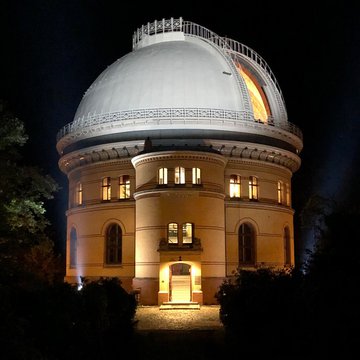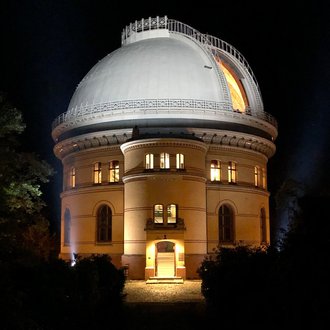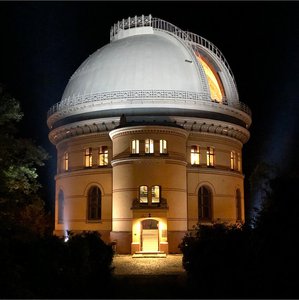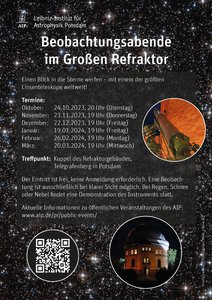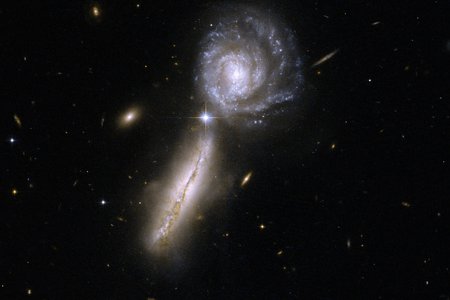Observation evenings at the Great Refractor
After a long break, the Great Refractor will again open its dome for public observation evenings. In Case of clear skies, everyone interested has the chance to take a look through the fourth-largest refracting telescope in the world and get to know the historic telescope.
The season starts with an observation evening on 24 October. Both the Moon and Saturn will be clearly visible that evening, weather conditions permitting. Other possible observation objects include the Andromeda Nebula and the Ring Nebula M57. The event is open to everyone and is free of charge. No registration is required. An observation is only possible during clear visibility. In case of rain, snow or fog only a demonstration of the instrument will take place.
In 1874, the Astrophysical Observatory Potsdam (AOP) was founded on what is now the site of the Telegrafenberg. The AOP played a leading role in the spectral study of stars. Due to the rather limited instrumentation, it was hardly possible to study fainter stars. Therefore, it was decided to build the Great Refractor. The refracting telescope was constructed between 1896 and 1899 and ceremonially inaugurated on 26 August 1899 in the presence of Emperor Wilhelm II. After war-related damage in 1945 and a subsequent modernization in 1953, the Great Refractor finally ceased operation completely in 1968. In 1997 the support association “Großer Refraktor Potsdam e.V.” was founded, which campaigned for the complete restoration of the dilapidated refractor. Restoration work lasted from 2003 to 2006 and finally on 31 May 2006, the Great Refractor shone in new brilliance at its rededication ceremony.
The Great Refractor is a double telescope with two separate telescopes in a common tube. The larger of the two telescopes, the astrograph, is intended for photography and has an 80-cm-diameter objective and a focal length of 12,2m. The smaller telescope, the guiding telescope, is intended for observations in the visible spectral range and has a diameter of 50cm and a focal length of 12.5m. The diameter of the 200-tons rotating dome is 21m.
The meeting point is in the dome of the refractor building.
Dates:
Tue 24 Oct. 2023 from 8pm
Thu 23 Nov. 2023 from 7pm
Fri 22 Dec. 2023 from 7pm
Fri 19 Jan. 2024 from 7pm
Mon 26 Feb. 2024 from 7pm
Wed 20 Mar. 2024 from 7pm
Directions:
The bus 691 departs every 20 minutes from the Potsdam central station to the “Potsdam Telegrafenberg” station. The last bus departs at 7:18 pm. Also see the map at Directions Telegrafenberg.
Further information
https://www.aip.de/de/pr/visit-the-telescopes/visiting-the-great-refractor/
After a long break, the Great Refractor will again open its dome for public observation evenings. In Case of clear skies, everyone interested has the chance to take a look through the fourth-largest refracting telescope in the world and get to know the historic telescope.
The season starts with an observation evening on 24 October. Both the Moon and Saturn will be clearly visible that evening, weather conditions permitting. Other possible observation objects include the Andromeda Nebula and the Ring Nebula M57. The event is open to everyone and is free of charge. No registration is required. An observation is only possible during clear visibility. In case of rain, snow or fog only a demonstration of the instrument will take place.
In 1874, the Astrophysical Observatory Potsdam (AOP) was founded on what is now the site of the Telegrafenberg. The AOP played a leading role in the spectral study of stars. Due to the rather limited instrumentation, it was hardly possible to study fainter stars. Therefore, it was decided to build the Great Refractor. The refracting telescope was constructed between 1896 and 1899 and ceremonially inaugurated on 26 August 1899 in the presence of Emperor Wilhelm II. After war-related damage in 1945 and a subsequent modernization in 1953, the Great Refractor finally ceased operation completely in 1968. In 1997 the support association “Großer Refraktor Potsdam e.V.” was founded, which campaigned for the complete restoration of the dilapidated refractor. Restoration work lasted from 2003 to 2006 and finally on 31 May 2006, the Great Refractor shone in new brilliance at its rededication ceremony.
The Great Refractor is a double telescope with two separate telescopes in a common tube. The larger of the two telescopes, the astrograph, is intended for photography and has an 80-cm-diameter objective and a focal length of 12,2m. The smaller telescope, the guiding telescope, is intended for observations in the visible spectral range and has a diameter of 50cm and a focal length of 12.5m. The diameter of the 200-tons rotating dome is 21m.
The meeting point is in the dome of the refractor building.
Dates:
Tue 24 Oct. 2023 from 8pm
Thu 23 Nov. 2023 from 7pm
Fri 22 Dec. 2023 from 7pm
Fri 19 Jan. 2024 from 7pm
Mon 26 Feb. 2024 from 7pm
Wed 20 Mar. 2024 from 7pm
Directions:
The bus 691 departs every 20 minutes from the Potsdam central station to the “Potsdam Telegrafenberg” station. The last bus departs at 7:18 pm. Also see the map at Directions Telegrafenberg.
Further information
https://www.aip.de/de/pr/visit-the-telescopes/visiting-the-great-refractor/
Images
Der Große Refraktor bei Nacht.
Big screen size [1000 x 1001, 150 KB]
Original size [1440 x 1442, 320 KB]
Flyer with dates of the observation evening (pdf, jpg)
Big screen size [1000 x 1413, 420 KB]
Original size [2481 x 3508, 1.6 MB]
